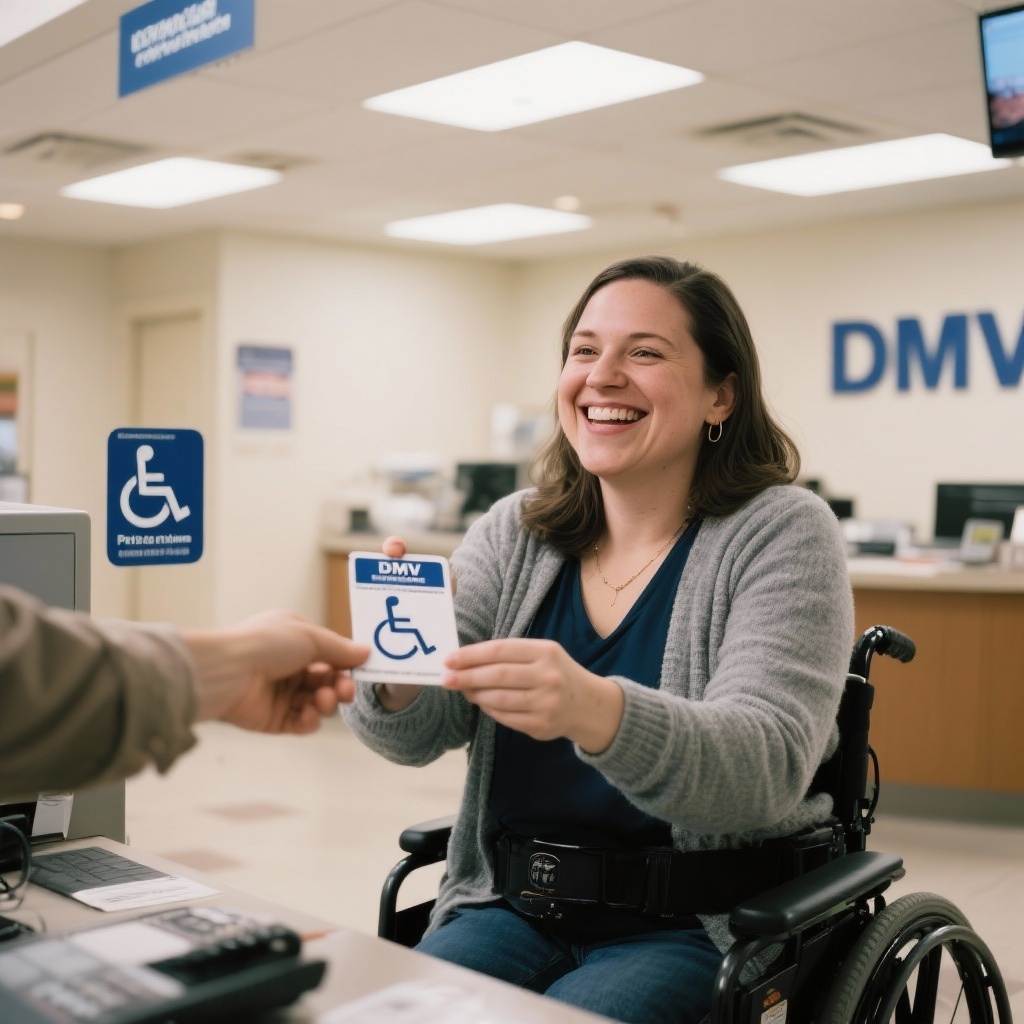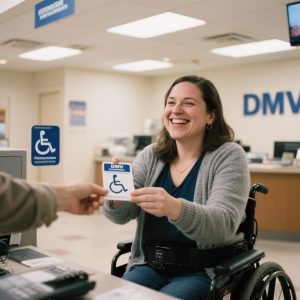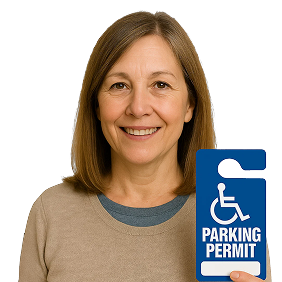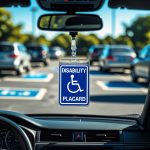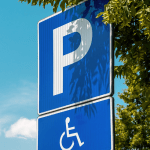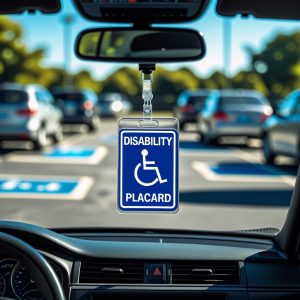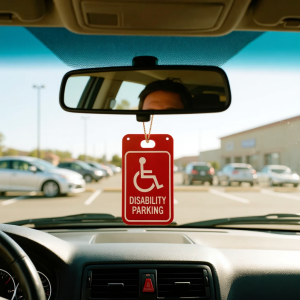For millions of Americans with mobility challenges, a DMV handicap placard (often called a disability parking permit or disabled parking placard) is more than a convenience, it’s a key to independence. It provides crucial access to designated parking spaces, making daily tasks manageable and reducing physical strain.
However, the application process can feel complex and confusing, with rules that vary significantly from state to state. According to the U.S. Census Bureau, approximately 44.1 million Americans have a mobility disability, yet many find the system for obtaining a placard creates more barriers instead of removing them.
This guide breaks down the entire process into 15 essential points, providing a clear, step-by-step roadmap. Whether you’re applying for the first time or renewing an expired permit, understanding these key aspects will help you navigate the system smoothly and confidently, ensuring you get the accessibility accommodation you need.
1. Understand the Different Types of Disability Parking Permits
Before you begin the application process, it’s important to know that not all permits are the same. The right choice for you depends on whether your condition is temporary or permanent. Each type serves a specific purpose and comes with its own set of rules.
Temporary Placard (Red):
This is designed for short-term disabilities, such as recovery from major surgery, a broken limb, or a pregnancy with complications. Red handicap placards are typically valid for 6 months up to a year and are only renewable if your condition persists. If you need one for a longer period, a new application with updated medical certification is required. The distinct red color helps law enforcement easily identify its temporary status.
Permanent Placard (Blue):
For individuals with a long-term or permanent condition that significantly impairs mobility, a permanent placard is the standard option. These are usually valid for several years, often between two and six, depending on the state and must be renewed upon expiration. The renewal process often requires a new medical certification, so it’s important to plan ahead.
Disabled License Plates:
Instead of a placard, you can opt for disability license plates for your vehicle. These are generally for permanent conditions and are tied to a specific vehicle. The main advantage is convenience, as they don’t need to be hung and removed like a placard. This can be particularly helpful if you always drive the same car.
2. Know What Medical Conditions Qualify for a Handicap Placard
Eligibility for a handicap placard is based on functional limitations rather than a specific diagnosis. While each state’s DMV has its own list, the qualifying medical conditions are generally consistent nationwide. The core principle is the impact of your condition on your ability to walk and navigate parking environments.
You typically qualify if you meet one or more of the following criteria:
- You cannot walk 200 feet without stopping to rest.
- You need to use a portable oxygen tank.
- You have a cardiac condition classified as Class III or IV by the American Heart Association.
- You have a severe lung disease that limits your ability to walk.
- You are legally blind.
- You have a neurological, orthopedic, or arthritic condition that significantly limits your mobility.
- You have a disability that restricts the use of a limb, requiring a wheelchair, crutch, cane, or another assistive device.
It’s important to discuss these functional criteria with your healthcare provider to determine if your situation meets the legal requirements.
3. Your Doctor’s Certification is the Most Critical Step
You cannot obtain a placard without certification from a licensed medical professional. This is the most important part of the entire process. The professionals authorized to certify your application can vary by state but typically include:
- Medical Doctors (MD) and Doctors of Osteopathy (DO)
- Physician Assistants (PA) and Nurse Practitioners (NP)
- Chiropractors (in many states, particularly for mobility-related conditions)
- Podiatrists (for foot-related disabilities)
Before scheduling an appointment, it’s a good idea to verify that your specific provider is authorized by your state’s DMV. An easier way is to get your health certification through ParkingMD, we have a team of licensed practitioners to help you with your disability permit.
During your appointment, be prepared to discuss how your condition impacts your daily mobility in specific terms. The doctor isn’t just confirming a diagnosis; they are assessing your functional limitations against the state’s legal standards. Providing clear examples, such as the need to stop and rest after walking a short distance, will help them complete the certification accurately.
4. State-Specific Requirements Can Vary Dramatically
One of the biggest sources of confusion is that handicap placard requirements are not uniform across the United States. What works in one state may be insufficient in another. These differences can include:
- The Application Form: Each state has its own form, often with a different number (e.g., Form MV-1459, VTR-214).
- Approved Medical Providers: While most states accept MDs and DOs, the rules for PAs, NPs, chiropractors, and podiatrists can differ.
- Submission Methods: Some states allow online submissions, while others require mail-in or in-person applications. For example, Virginia’s DMV offers an online application portal for certain applicants.
- Walking Distance Criteria: Although 200 feet is a common standard, some states have slightly different requirements.
Your first and most crucial step should always be to visit your state’s official DMV website to download the correct forms and review the specific instructions. Relying on general information without checking your state’s rules is a common mistake that leads to delays.
5. Being Prepared is the Easiest Way to Avoid Delays
There is no magic shortcut, but being thoroughly organized is the closest thing to an “easy button” for this process. A little preparation can prevent weeks of back-and-forth. Here’s how to be prepared:
- Download the Form First: Never assume your doctor’s office has the latest application form. Download it directly from your state’s DMV website and bring it with you to your appointment. For instance, California’s forms are available on the CA DMV disabled placard page. On the other hand, when you apply through ParkingMD, we’ll make sure to give you the right form for your state so you won’t have to worry.
- Gather Your Information: Have your driver’s license number or state ID number ready when filling out the form.
- Compile Medical Documentation: While the doctor’s certification is key, having relevant medical records on hand can support your case during the evaluation.
Taking these steps ensures that you and your doctor can complete the process efficiently during a single appointment.
6. Understand the Costs and Fee Structures
The financial aspect is a common concern, but the good news is that the cost of a handicap placard is often very low. However, the details matter and vary by state.
- Permanent Placards: These are frequently issued free of charge in many states, including California and Texas.
- Temporary Placards: These usually involve a small fee, typically ranging from $5 to $25.
- License Plates: Standard disability plates may involve regular registration fees, but specialty plates might have an additional cost.
It’s always best to check your local DMV website for the most accurate and current fee structure to avoid any surprises.
7. Processing and Waiting Times Depend on Your Location
After you submit your application, patience is key. Processing times are not standardized and can be influenced by the method of submission and the efficiency of your local DMV office. Generally, it can take up to 2-4 weeks.
- Mail-In Applications: These can take several weeks, as they involve processing time and mail delivery.
- In-Person Applications: Submitting in person might lead to a shorter processing time, but you must contend with potential wait times at the DMV office.
- Online Applications: In states that offer them, online submissions can be the fastest option.
It’s wise to apply well before you urgently need the placard. Submitting a complete and error-free application is the best way to prevent unnecessary delays.
8. Proper Display of Your Placard is Non-Negotiable
Receiving your placard is only half the battle; using it correctly is essential to avoid fines and ensure its benefits. The rules for display are strict and must be followed meticulously.
- Hang it Clearly When Parked: Always hang the placard from your rearview mirror, facing forward so that all information, including the expiration date, is clearly visible through the windshield. If your vehicle has no rearview mirror, placing it on the dashboard is usually acceptable.
- Remove It While Driving: It is both illegal and a serious safety hazard to drive with the placard hanging from the mirror, as it obstructs your view of the road.
- It’s for You, Not Your Vehicle: The placard is assigned to you, not to a specific car. This means you can use it in any vehicle you are traveling in as a passenger. However, it is illegal for anyone to use the placard when you are not present.
9. Keep Copies of All Your Paperwork
This simple habit can save you a significant amount of time and frustration in the future. During the application process, ask your doctor for multiple certified copies of the completed medical certification form. Also, make copies of your entire application package before you submit it.
Why is this important?
- Renewals: When it’s time to renew, you may need to provide information from your original application.
- Replacements: If your placard is lost, stolen, or damaged, having copies of your paperwork will streamline the replacement process. You may need to file a report and pay a small fee, but you won’t have to go through a new medical evaluation.
- Moving to a New State: If you move, some states may accept your previous certification, making the transition smoother.
10. Start the Renewal Process Well in Advance
Don’t wait until the last minute to think about renewing your permanent placard. The renewal process can sometimes be as involved as the initial application, potentially requiring a new doctor’s certification. Mark your calendar with a reminder 60-90 days before the expiration date. This gives you ample time to schedule a doctor’s appointment if needed and complete the paperwork without a rush. Many states do not send out renewal reminders, so this responsibility falls on you.
11. Know the Procedures for Lost or Stolen Placards
Losing your placard is inconvenient, but it happens. The process for getting a replacement is different from the initial application. Typically, you will need to:
- File a report with local law enforcement if it was stolen.
- Complete a specific “Replacement Placard” form available from your DMV.
- Submit the form along with a small replacement fee.
As mentioned, having copies of your original medical certification will make this process much faster and easier, as it proves you were already approved.
12. Understand Local Parking Regulations
Having a placard grants you access to designated accessible parking spaces, but it’s important to understand that local regulations can vary. The Americans with Disabilities Act (ADA) sets federal standards, but cities and private property owners may have additional rules.
- Time Limits: Some accessible spaces, even in public areas, may have enforced time limits.
- Van-Accessible Spaces: These spaces have extra room for ramps and are reserved for vehicles equipped with or used by individuals who require a wheelchair ramp.
- Private Property: Rules in shopping malls or private parking lots must still comply with the ADA, but enforcement may differ.
Familiarize yourself with the signs posted in parking areas to ensure you are parking correctly and avoiding fines.
13. Avoid These Common Mistakes
A simple oversight can lead to a rejected application or a fine. Be sure to avoid these common pitfalls:
- Incomplete Forms: A missing signature, either yours or your doctor’s, is the most common reason for immediate rejection. Double-check every section.
- Using an Expired Placard: Law enforcement regularly checks expiration dates. Using an expired placard can result in a substantial fine.
- Lending Your Placard: This is a serious offense. The placard is for your use only when you are present. Allowing someone else to use it can lead to its revocation and significant penalties.
- Assuming Universal Rules: Remember that rules can differ by city and state. What is allowed in one municipality might be prohibited in another.
14. View the Process as a Manageable Project
The process for getting a disability parking permit is a bureaucratic one, but it doesn’t have to be overwhelming. The most successful applicants approach it as a manageable project with clear steps: research state requirements, gather documentation, complete forms with care, and submit everything correctly. With millions of Americans having a mobility issue, the system is designed to provide access. By being organized and methodical, you can navigate it successfully and secure the parking accommodations that promote your independence and quality of life.
Takeaway Note
Obtaining a DMV handicap placard is a structured process designed to ensure access for those who need it. By understanding the different types of permits, confirming your eligibility through a conversation with your doctor, and carefully following your state’s specific application instructions, you can secure your disability parking permit efficiently. This small card can make a significant difference in your daily life, granting you the accessibility and independence you deserve.
FAQs
What is the easiest way to get a handicap placard?
The easiest way is through thorough preparation. This means downloading the correct form from your state’s DMV website before your doctor’s appointment, having your personal documents ready, and ensuring your healthcare provider fully completes their section. This can be expedited by applying via ParkingMD.
What qualifies you for a handicap placard?
Qualification is based on significant mobility impairment. This includes an inability to walk 200 feet without resting, the use of portable oxygen, severe cardiac or lung conditions, legal blindness, or conditions that require the use of an assistive device like a wheelchair, cane, or crutch.
How much does a handicap placard cost in MD?
In Maryland, both permanent and temporary handicap placards are free but there is a $20 fee for license plates. It’s always best to check the Maryland Motor Vehicle Administration (MVA) website for the most current fee schedule.
How long does it take to get a CA DMV disabled placard?
The California DMV typically states that it takes approximately 3 to 4 weeks to process and mail a disabled placard after receiving a completed application. Processing times can be longer during peak periods.
Can I use my handicap placard in other states?
Yes, handicap placards are generally recognized across all 50 states. The Americans with Disabilities Act (ADA) ensures that disability parking privileges are honored nationwide. However, it’s important to always follow the specific parking regulations of the state you’re visiting, as time limits or special zoning rules may differ.

